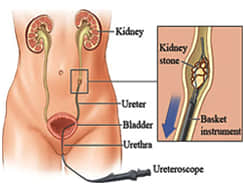What does the procedure involve?
Insertion of a fine flexible telescope up the ureter all the way to the kidney if necessary. This is usually performed to remove a stone(s) but can also be done occasionally to diagnose abnormalities in the inner lining of the ureter or kidney. It may involve placement of a soft plastic tube or stent between the kidney and the bladder. The procedure also includes cystoscopy and X-ray screening.
What are the alternatives to this procedure?
- Shock wave therapy (lithotripsy).
- Percutaneous Nephrolithotomy (PCNL).
- Open or laparoscopic surgery to remove stone.
- Observation to allow spontaneous passage of stone if it is small (<5mm).
What should I expect before the procedure?
You will usually be admitted to hospital on the same day as your surgery. Immediately before the operation, the anaesthetist may give you a pre-medication, which will make you dry-mouthed and pleasantly sleepy.
Please tell your surgeon (before your surgery) if you have any of the following:
- An artificial heart valve.
- A coronary artery stent.
- A heart pacemaker or defibrillator.
- An artificial joint.
- An artificial blood-vessel graft.
- A neurosurgical shunt.
- Any other implanted foreign body.
- A regular prescription for a blood thinner e.g. Warfarin, Coumadin, Xarelto®, Pradaxa®, Clopidogrel (Plavix®), Brilinta®, or Aspirin.
- Previous or current infection with an antibiotic resistant organism such as MRSA, VRE, etc.
What happens during the procedure?

A full general anaesthetic is normally used and you will be asleep throughout the procedure. You will usually be given an injection of antibiotics before the procedure, after you have been checked for any allergies.
The surgeon will insert a telescope into the bladder through the water pipe (urethra). Under X-ray guidance, a soft guidewire will be inserted into the affected ureter up to the kidney. A longer and finer telescope (flexible ureteroscope, pictured) will then be inserted over the wire and passed up to the kidney. Stone(s) can be disintegrated using a laser fibre passed through the flexible ureteroscope, and the fragments extracted with special retrieval devices (stone basket).
If you are having this procedure for a suspected abnormality of the inner lining of the ureter or kidney, biopsies can be taken and small lesions can be cauterised with diathermy or laser.
A ureteric stent is normally left in place, which will need to be removed a few days or weeks later. Also, a bladder catheter is sometimes inserted for a day or two after surgery.
What happens immediately after the procedure?
If a bladder catheter has been inserted, this will normally be removed on the day after surgery. You will be able to go home once you are passing urine normally.
An X-ray is often done on the day after surgery to check on the presence of residual stone fragments. The average hospital stay is one day.
Are there any side-effects?
Most procedures are straightforward but as with any operation there are potential complications and side-effects.
Common (greater than 1 in 10)
- Failure to pass the flexible ureteroscope due to a tight ureter – in this instance a stent is usually inserted to dilate the ureter and another attempt made to insert the flexible ureteroscope a few weeks later.
- Mild burning or bleeding on passing urine for short period after the operation.
- Insertion of a stent, which will need a further procedure to remove it. The stent may cause pain, frequent urine passage and bleeding in the urine until it is removed.
- Recurrence of stones.
Occasional (between 1 in 10 and 1 in 50)
- It may not be possible to retrieve some or all of the stone necessitating a repeat operation on another occasion.
- Displacement of the stone into an inaccessible site in the kidney.
- Kidney damage or infection needing further treatment.
Rare (less than 1 in 50)
- Damage to the ureter with need for open operation or tube placed into kidney directly from the back to allow any leak to heal.
- Very rarely, scarring or stricture of the ureter needing further procedures.
What should I expect when I get home?
When you get home, you should drink twice as much fluid as you would normally to flush your system through and minimise any bleeding. You may experience pain in the kidney over the first 24 to 72 hours; this is due to swelling caused by the instrument or by the presence of a stent. Anti-inflammatory painkillers will help this pain, which normally settles after 72 hours.
It will take at least 10 days to recover fully from the operation and you should not expect to return to work within seven days.
What else should I look out for?
Small blood clots or stone fragments may pass down the ureter from the kidney, resulting in renal colic.
If you develop a fever, severe pain on passing urine, inability to pass urine or worsening bleeding, you should contact your Surgeon or GP immediately. In case of an emergency attend your nearest emergency department or call ‘000’.
Are there any other important points?
If a stent has been inserted, we will let you know, before you go home, when the stent needs to be removed. Ureteric stents are usually removed under local anaesthetic or light sedation.
You can prevent further stones by changes to your diet and fluid intake. If you have not already received a written leaflet about this, contact your urologist.
Disclaimer
This information is intended as a general educational guide and may not apply to your situation. You must not rely on this information as an alternative to consultation with your urologist or other health professional.
Not all potential complications are listed, and you must talk to your urologist about the complications specific to your situation.
